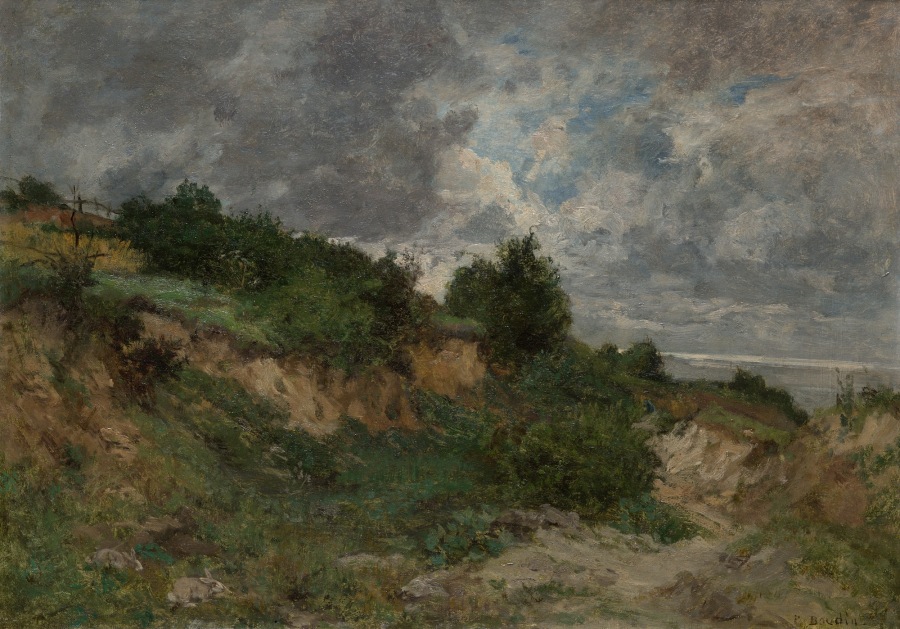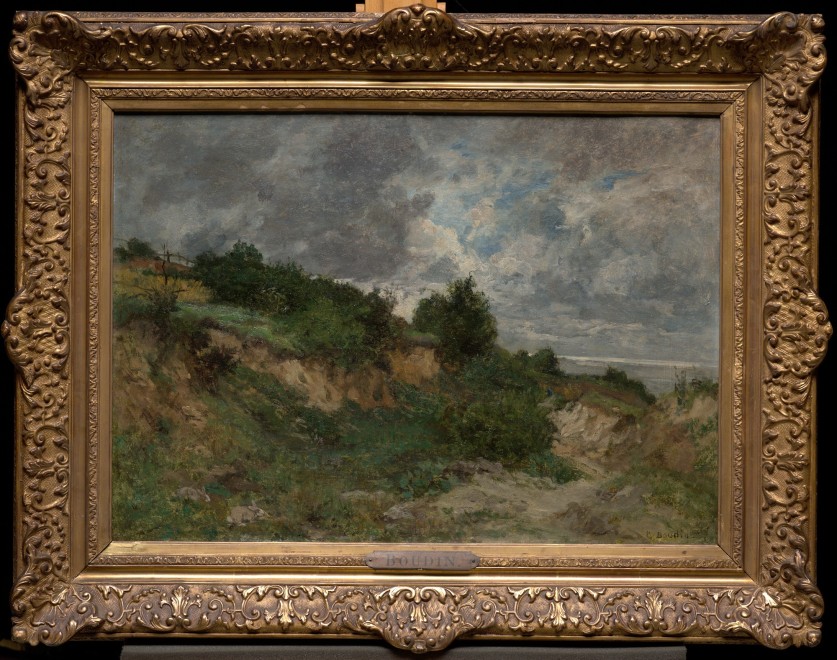Provenance
Private Collection, France
Literature
Robert Schmit, Eugène Boudin, Paris, 1973-1993, vol. I, no. 40, p. 13 (illustrated)
Catalogue note
In this evocative landscape, Eugène Boudin transports us to the rugged, windswept terrain of Normandy’s coastline, likely near the village of Villerville. Painted between 1850 and 1860, this work may capture a stretch of the beachside thicket, where Boudin is believed to have painted alongside his close friend and fellow artist Charles-François Daubigny (1817-1878). This was a formative time for Boudin, who was still exploring his artistic identity while drawing inspiration from nature’s quiet power and the changing moods of the sky.
The painting offers a vivid interplay between land and atmosphere: a sandy path meanders through overgrown vegetation, leading the viewer’s eye up a slope crowned with scraggly bushes and scattered trees. The sky—always central in Boudin’s compositions—dominates the upper portion of the canvas with heavy, fast-moving clouds, rendered in cool greys and soft blues. The light breaks subtly along the horizon, suggesting the promise of clearing skies or perhaps a storm’s retreat. Earthy browns and lively greens ground the lower half, where the landscape’s wildness is gently tamed by the painter’s brush. There is no overt human presence, yet the scene hums with quiet energy and the unseen motion of wind and weather.
Born in 1824 in Honfleur, a small port town just across the Seine estuary from Villerville, Boudin was a child of the sea. His father, a harbor pilot, and the bustling maritime life around him nurtured a lifelong fascination with ships, skies, and coasts. As a young man in Le Havre, Boudin worked in a frame shop, where he encountered established artists such as Jean-François Millet (1814-1875) and Constant Troyon (1810-1865). These meetings, combined with his own observations of nature, encouraged him to pursue painting seriously by his early twenties.
Though trained briefly in Paris, Eugène Boudin found his true artistic voice along the Normandy coast, where he pioneered the practice of painting outdoors to capture the fleeting effects of light and atmosphere. His influence on a young Claude Monet (1840-1926), whom he introduced to plein air painting in 1858, proved pivotal for the development of Impressionism. This early canvas, painted well before the first Impressionist exhibition, already embodies that spirit: loose, fluid brushwork and a sensitive rendering of sky, wind, and foliage convey not a fixed moment, but nature in motion.
Villerville, a small fishing village nestled between Trouville and Honfleur, was a favorite retreat for Boudin. With its sloping cliffs, tangled greenery, and sweeping views across the water, it offered the same natural allure as nearby Deauville but with a quietude that allowed him to work undisturbed. Here, away from the distractions of Paris, Boudin immersed himself in the subtleties of nature, while his friendship with Daubigny, another devoted admirer of the Barbizon School’s naturalism, deepened during this formative period. The works he created in Villerville stand among the earliest visions of what would become modern landscape painting. With their natural palette, sensitive handling of light, and expressive skies, they reflect an artist deeply attuned to the rhythms of the natural world—a painter whose eye, as Monet once said, taught others to truly see.
This note was written by Elsa Dikkes.




